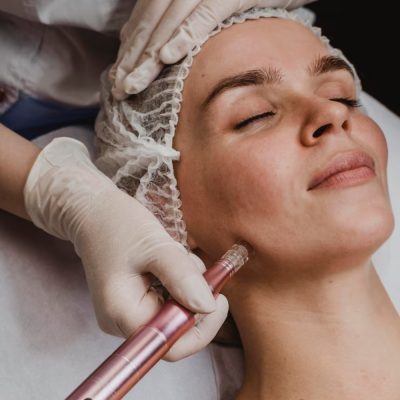Q-Switched Nd:YAG Laser (Tattoo Removal, Pigmentation Treatment, Birthmark Removal, Acne Treatment & Skin Rejuvenation)
Q-Switched Nd:YAG laser treatments have become a cornerstone in dermatology and aesthetic medicine due to their effectiveness in treating a variety of skin concerns. This laser uses high-intensity pulsed light that targets specific pigments in the skin, making it ideal for removing tattoos, treating hyperpigmentation, and rejuvenating the skin.

What is a Q-Switched Nd:YAG Laser?
Q-Switched Nd:YAG laser is a highly versatile and effective treatment option that utilizes laser technology to target pigmentation, unwanted tattoos, and various skin lesions. The “Q-Switched” technology allows the laser to deliver powerful energy pulses in extremely short bursts, which shatter pigment particles without damaging the surrounding skin tissue. The Nd:YAG (neodymium-doped yttrium aluminum garnet) laser operates at two wavelengths—1064 nm and 532 nm—allowing it to penetrate deeply into the skin, making it suitable for treating both superficial and deep pigmentation.
What are the Different Treatments with Q-Switched Nd:YAG Laser?
Tattoo Removal
Q-Switched Nd:YAG laser is one of the most effective tools for removing tattoos. It works by breaking down the ink particles in the skin, which are then naturally cleared away by the body’s lymphatic system.
Pigmentation Treatment
This laser is highly effective in treating hyperpigmentation, including melasma, sunspots, age spots, and freckles. It selectively targets pigmented areas, breaking down the excess melanin responsible for the discoloration.
Skin Rejuvenation
Q-Switched Nd:YAG laser helps in improving skin texture, reducing fine lines, and stimulating collagen production. It can also minimize pore size, giving the skin a smoother and more youthful appearance.
Acne Treatment
By stimulating collagen and elastin production, this laser treatment can help reduce the appearance of acne scars, making the skin appear more even and refined.
Method & Treatment of Q-Switched Nd:YAG Laser
Treatment Procedure
Consultation
A thorough consultation is conducted by an experienced dermatologist to assess the skin condition, discuss the patient’s goals, and determine the appropriate treatment plan.
Preparation
The skin is cleansed, and protective eyewear is provided to shield the eyes from the laser light. A topical anesthetic may be applied to minimize discomfort.
Laser Application
The Q-Switched Nd:YAG laser is applied to the treatment area using a handheld device. The laser emits short pulses of light that target the pigmented cells or tattoo ink.
Duration
The procedure typically takes 15-30 minutes, depending on the size and number of areas being treated.
Post-Treatment Care
After the treatment, a soothing cream may be applied, and sunscreen is recommended to protect the treated area from sun exposure.
Results
Results can vary depending on the treatment purpose. Pigmentation may lighten within a few sessions, while tattoo removal may require multiple treatments spaced several weeks apart. However, for smaller or spot tattoos, a single sitting may suffice.
Applied Areas for Q-Switched Nd:YAG Laser
Face
For pigmentation, melasma, and skin rejuvenation.
Neck & Décolleté
To improve skin tone and texture.
Hands & Arms
To treat sunspots, signs of aging and tattoo removal.
Back & Chest
For acne, tattoo removal and pigmentation treatment.
Body
For tattoo removal from various areas of the body.
Precautions and Risks of Q-Switched Nd:YAG Laser
- Avoid using products that can irritate the skin, such as retinoids or acids, a few days before the treatment.
- Avoid excessive sun exposure and use sunscreen to protect the skin before and after the procedure.
- Ensure to inform your dermatologist of any medical conditions, medications, or history of skin sensitivities.
- Mild redness, swelling, or pinpoint bleeding may occur post-treatment but typically resolves within a few days.
- There is a risk of temporary changes in skin color, especially in darker skin types.
- Rarely, improper settings or skin sensitivity can lead to scarring or blistering.
Post-Procedure Signs to Look Out For
Redness or Swelling: Mild redness or swelling around the treated area is normal and usually subsides within a few hours to days.
Darkening of Pigmented Spots: Treated pigmentation may initially darken before it lightens and eventually fades away.
Crusting or Flaking: The skin may crust or flake as it heals, especially in tattoo removal or pigmentation treatments.
Patients should avoid picking or scratching the treated area and follow post-care instructions provided by the dermatologist.
Complementary Cosmetic Procedures for Better Outcomes
Pairing Q-Switched Nd:YAG laser treatments with other cosmetic procedures can enhance results and provide comprehensive skin rejuvenation:
Chemical Peels
Combining with chemical peels can enhance the exfoliation and brightening effects, particularly for pigmentation concerns.
Microneedling Radio Frequency (MNRF)
MNRF can be used alongside Q-Switched Nd:YAG laser to boost collagen production and further improve skin texture.
Hydrafacial
A hydrafacial can prepare the skin before laser treatment by deeply cleansing and hydrating the skin, enhancing the overall results.
Platelet-Rich Plasma (PRP) Therapy
PRP therapy can be combined to accelerate healing and further rejuvenate the skin.
Intense Pulsed Light (IPL) Therapy
For patients with pigmented lesions, combining Nd:YAG with IPL can target a broader range of skin concerns.
High-Intensity Focused Ultrasound (HIFU)
For additional skin tightening and contouring, complementing the anti-aging benefits of the laser.
